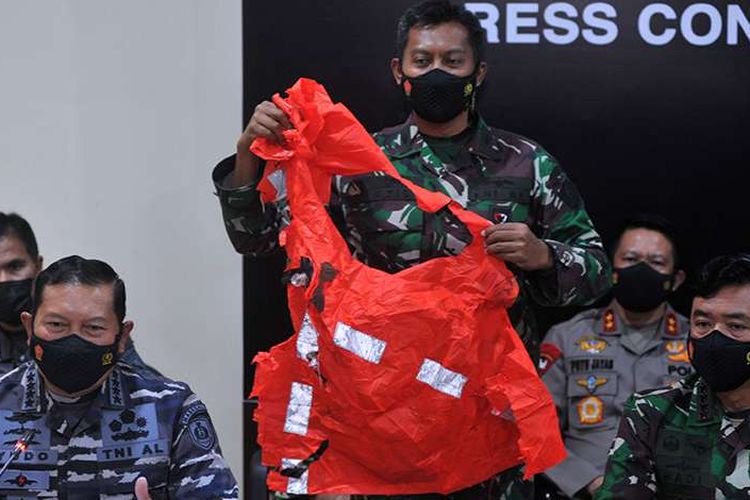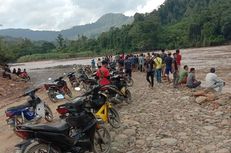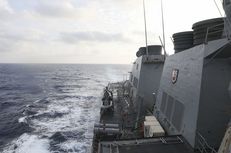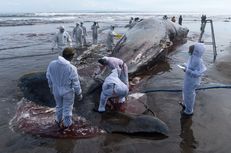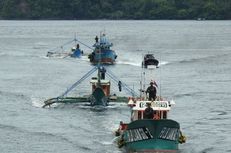
KOMPAS.com - Indonesian authorities have confirmed that the KRI Nanggala 402 submarine has sunk and all 53 crew members have fallen.
There are unanswered questions about what caused the disaster. But with the submarine now located on the ocean floor, what happens next?
First of all, what do we know about the incident?
On Wednesday, the KRI Nanggala 402 submarine lost contact off the coast of Bali.
The submarine was conducting torpedo drills when it went missing.
The 53 on board included 49 crew, three torpedo gunners, and the commander of Indonesia's submarine fleet. Their oxygen supply was due to run out on Saturday morning.
An underwater robot photographed the lost submarine lying broken up in three separate pieces on the ocean floor, the Indonesian Navy chief of staff Admiral Yudo Margono said.
"The KRI Nanggala is divided into three parts, the hull of the ship, the stern of the ship, and the main parts are all separated, with the main part found cracked," he said.
It sank to a depth of 838 meters — far below the submarine's maximum operating depth of about 250 meters. "Down to 500 meters, the hull could recover from any deforming that would occur from the pressure, because submarines do compress and then expand again," Frank Owen, secretary of the Submarine Institute of Australia, told the ABC.
"But below that, it rapidly gets more and more deformed, and would never recover from it, until eventually the plates themselves apart, or they rupture."
Why did the submarine sink?
The cause is still unknown, but Admiral Margono said the initial analysis suggested it was due to "natural factors", rather than human error or technical problems.
"We have evaluated it from the beginning and we believe this is not a human error, but more due to natural factors," he said in Bali on Sunday, April 26, without elaborating on what those factors were.
Margono said he believed that there was no human negligence and that the submarine had "followed all procedures needed".
The navy previously said an electrical failure could have left the submarine unable to execute emergency procedures to resurface.
But Admiral Margono said on Sunday he wasn't sure about a possible black-out as the cause, because he said during the diving process all the lights were still on.
"This means that the power was not immediately lost when diving," he said.
However, he said to determine the exact cause, they will investigate the remaining parts of the submarine.
The German-built submarine was more than 40 years old — it was constructed in 1978 — and it has been nine years since its last refit.
Military officials said the submarine went for maintenance in South Korea in 2009 and 2012, and its dive depth increased to around 250 meters.
They said the upper structure of the ship was partially replaced, while the weapons, sonar, radar, combat control, and propulsion systems were upgraded.
Owen said all we know for now is that the submarine sunk and that we won't know more until detailed analysis and research can be done.
"All the evidence that's coming up is just reinforcing that it was probably … a quick end to the submarine," he said.
An orange suit was found. Does that tell us anything?
 Indonesia Military (TNI) commander Air Chief Marshal Hadi Tjahjanto (right) and Navy chief of staff Admiral Yudo Margono (left) showing an escape suit in orange color belongs to the sailors of KRI Nanggala 402 submarine during a press conference in Bali, Sunday, April 25, 2021.
Indonesia Military (TNI) commander Air Chief Marshal Hadi Tjahjanto (right) and Navy chief of staff Admiral Yudo Margono (left) showing an escape suit in orange color belongs to the sailors of KRI Nanggala 402 submarine during a press conference in Bali, Sunday, April 25, 2021. A bright orange escape suit floating in the dark water may give a glimpse into the final moments for the crew.
"This escape suit was usually kept in a box. The fact that it has come out of the box means there was an emergency," Admiral Margono said.
"Either they were not able to put the suits on fast enough, or the submarine shook while they were trying to put them on."
Other objects were also found by search teams on Saturday, including a bottle of periscope lubricant and fragments of prayer mats.
Those discoveries led the navy to believe the vessel had cracked. "Inside the submarine, the pressure remains about the same until such time as the as the hull is breached, and water comes in, then there's a very rapid increase in pressure," Owen said.
"And down to a reasonable depth of, say, 200 meters, the body can deal with it. "But when you get this rapid increase, it's just catastrophic."
What happens to the submerged bodies now?
 Murhaleni (wearing orange headscarf) who is the mother of Lieutenant Colonel Heri Oktavian, the commander of Indonesia's KRI Nanggala 402 submarine fleet, speaks to a spokesperson for Lampung Police on Saturday, April 24, 2021.
Murhaleni (wearing orange headscarf) who is the mother of Lieutenant Colonel Heri Oktavian, the commander of Indonesia's KRI Nanggala 402 submarine fleet, speaks to a spokesperson for Lampung Police on Saturday, April 24, 2021. Indonesia's navy has said it eventually wants to bring the submarine, and the bodies of the deceased crew, to the surface.
"Lifting a submarine is a very, very significant logistic feat," Owen said, adding that "retrieving the bodies individually, or without lifting the whole submarine, would be a real challenge".
"You're dealing with remotely operated vehicles, that are not necessarily having the complexity and ability of a hand to take control of body parts."
He pointed out the Russian nuclear submarine, the Kursk was raised in 2001. The sub, which weighed about 20,000 tons, was lifted from a depth of just over 100 meters, but it took over a year to bring it up.
In contrast, the KRI Nanggala 402 is much lighter, at 1,400 tons, but also much deeper, at more than 800 meters.
"But even to lift a 1,400-ton submarine from the seabed requires a lot of logistics," he said.
"You've got to get the right ships in place, you then have to get all the way down to the seabed, and 840 meters is a long way down.
"You then have to get some form of flotation on the submarine, which would usually be things like diesel-filled bags that can then provide buoyancy — air is useless at that depth."
Tributes flow for sub on 'eternal patrol'
Indonesia's President Joko Widodo expressed his condolences to all the families.
Online, there has been an outpouring for the victims of the Nanggala – named after a divine weapon from traditional Indonesian puppetry, which, according to legend, can melt mountains and split the ocean.
Social media users have referred to the submarine as now being "on eternal patrol."
Simak breaking news dan berita pilihan kami langsung di ponselmu. Pilih saluran andalanmu akses berita Kompas.com WhatsApp Channel : https://www.whatsapp.com/channel/0029VaFPbedBPzjZrk13HO3D. Pastikan kamu sudah install aplikasi WhatsApp ya.



